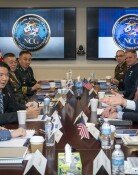High-tech industrial complexes fuel national competition
High-tech industrial complexes fuel national competition
Posted April. 07, 2023 08:10,
Updated April. 07, 2023 08:10
A total of 15 national advanced industrial complexes have been selected as candidates by the South Korean government, including the “high-tech system semiconductor cluster” in Yongin, Gyeonggi Province, in which Samsung Electronics is planning to invest 300 trillion won over the next 20 years. Among them, three specialized complexes in the fields of semiconductors, displays, and secondary batteries are expected to be selected in the first half of this year. Competition is intensifying among local governments across the country to revive declining local industry ecosystems by harnessing this opportunity.
Korea’s industrial complexes have been the driving force behind South Korea’s strong export since the enactment of the Export Industrial Complex Development Act in 1964 and the establishment of the Guro Industrial Complex in 1967 in accordance with this law. Currently, 2.3 billion employees are working in 120,000 companies in 1,274 industrial complexes. Last year, 65% of Korea’s exports came from industrial complexes. However, local industrial complexes are becoming moribund due to recent rapid export declines and severe labor shortages.
The National High-tech Strategic Industry Act, enacted in January last year, is expected to be an opportunity to upgrade outdated industrial complexes. When companies moving into the specialized industrial complexes affected by this law apply for permission for power, water, and location, local government must decide on approval within 60 days. Once this period passes, permission is considered to have been granted, subsequently speeding up the process. This is expected to prevent a recurrence of problems such as the transmission line issue that delayed the construction of Samsung Electronics' Pyeongtaek semiconductor plant for five years and the water issue that hindered the construction of SK hynix's Yongin semiconductor plant for over a year.
Amid the competition for economic hegemony between the US and China and the restructuring of global supply chains, countries around the world are engaging in a speed race to establish a domestic manufacturing base for advanced industries. Taiwan is in the process of converting major locations across the country into industrial complexes, starting with the "Hsinchu Science Park" where TSMC is located. Japan plans to build the Kumamoto Prefecture semiconductor industrial complex, which will take five years to complete, in just two years to reclaim leadership in the semiconductor industry lost to Korea and Taiwan. In the Silicon Saxony industrial complex in Germany, which produces one-third of Europe's semiconductors, 2,500 companies are forming a cluster to create a semiconductor ecosystem.
Establishing advanced industrial complexes has become a national competition that determines the future of each country. The key to victory lies in which country can complete its industrial complexes faster to secure global competitiveness, and how much regulatory leeway the government and local governments can offer and provide support. The ability to supply enough young talent, the core of the workforce in industrial complexes, is also a critical factor that determines success. Korea has risen to the world’s No. 1 in memory semiconductors and displays from scratch, and it will take unprecedented agility to prevail again.







